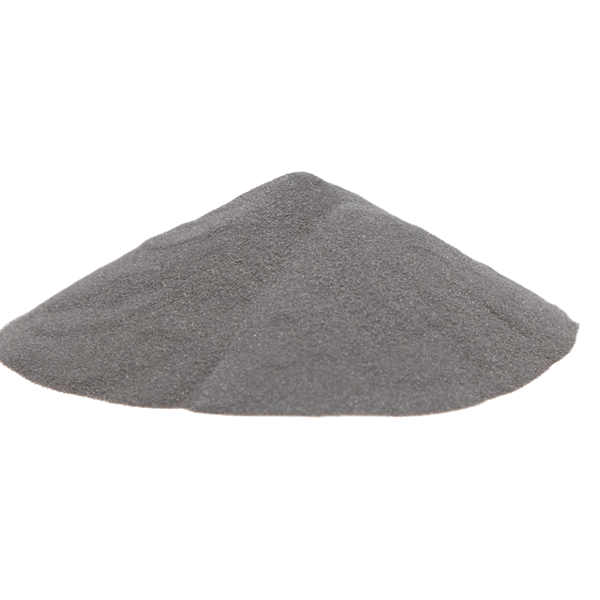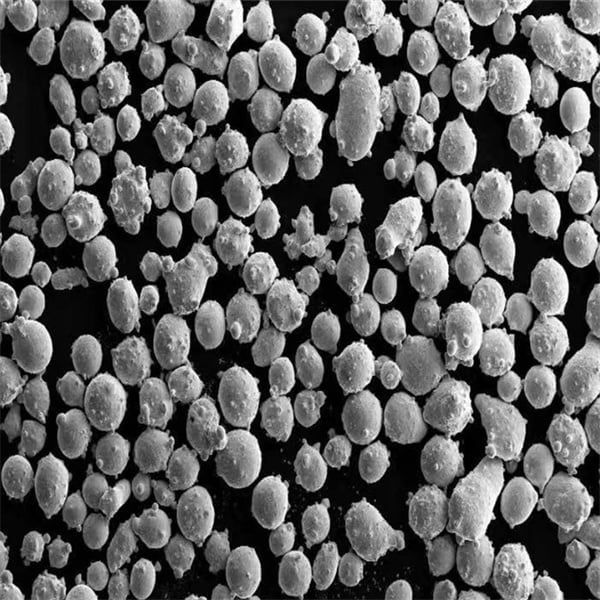3D tisk měděného prášku
Obsah
Přehled o 3D tisk měděného prášku
3D printing copper powder is a metal powder made of pure copper or copper alloys used as the raw material in various 3D printing technologies for manufacturing end-use copper parts and products.
Some key properties and advantages of using 3D printing with copper powder include:
- High electrical and thermal conductivity desired for electronics applications
- Very high machinability ratings for good finish and post-processing
- Excellent mechanical properties like strength and ductility
- Corrosion resistance due to protective copper oxide layer formation
- Bio-compatible for medical devices and implants
- Cost advantage compared to conventional copper machining
Several metal 3D printing processes utilize copper powder, most commonly:
Types of 3D Printing Using Copper Powder
| Technologie 3D tisku | Popis |
|---|---|
| Tryskání pojiva | Glues copper powder using liquid binding agents |
| Usměrněná depozice energie (DED) | Uses laser or electron beam to melt copper powder |
| Selektivní laserové tavení (SLM) | Selectively laser melts and fuses copper powder bed |
These additive manufacturing techniques allow creating complex geometries with copper not feasible by casting or machining. Parts can be fabricate on demand without tooling or molds.
Now let’s take a deeper look into copper grades for 3D printing, properties, applications, specifications, pricing, comparisons and more.

Složení 3D tisk měděného prášku
There are a few main types of copper metal powders used in additive manufacturing:
Compositions of 3D Printing Copper Powder
| Typ prášku | Typické složení |
|---|---|
| Čistá měď | 99.7% Cu minimum |
| Copper-tin alloy | Cu-10Sn bronze alloy |
| Copper-nickel alloy | 90Cu-10Ni or 70Cu-30Ni |
Characteristics of 3D Printed Pure Copper Parts
- Excellent electrical conductivity for electronics
- Ductile material allowing post-processing
- Annealing can further enhance ductility
- Low hardness at 100 HV after printing
Klady
- Highest thermal and electrical conductivity
- Easy to machine, plate, coat post-build
- Bio-compatible for medical uses
- Welding dissimilar metals is simplified
Nevýhody
- Soft low-strength textures and features
- Risk of delamination between layers
- Oxide film formation prone to contamination
Characteristics of 3D Printed Cu-Sn Bronze Parts
- Better mechanical properties with tin alloying
- Up to double the hardness and strength
- Move wear-resistant surface finish
- Higher temperature resistance
Klady
- Stronger parts to resist deformation
- Allows printing fine details and textures
- Small amounts of tin enhance properties
- Dobrá odolnost proti korozi
Nevýhody
- Nižší tepelná a elektrická vodivost
- Higher density increases weight
- Still require supports during printing
Characteristics of 3D Printed Cu-Ni Alloy Parts
- Excellent combination of strength plus conductivity
- Maintains high ductility and thermal properties
- Adds hardness for wear protection
- Solders well with other copper components
Klady
- Tunable properties balancing strength, hardness and conductivity
- Strong parts able to withstand stress
- Just 10% nickel doubles the yield strength
- Lower melting point benefits lower-temp printing
Nevýhody
- Not bio-compatible for medical devices
- Nickel can initiate galvanic corrosion
- Higher material costs than pure copper
Applications of 3D Printed Copper
Thanks to its versatile material properties, 3D printing with copper powder is used across industries:
Applications of 3D Printing Copper Powder
| Průmysl | Běžné aplikace |
|---|---|
| Elektronika | Interconnects, contacts, terminals, EMI shielding |
| Elektrické | Bus bars, rotor windings, electromagnets |
| Výměníky tepla | Heat sinks, evaporators, condensers |
| Automobilový průmysl | Welding tips, bushings, bearings |
| Architektura | Decorative facades, panels, modeling |
| Lékařský | Electrodes,GREENs, implants, surgical tools |
Some specific product examples include:
Elektronika: Conductive traces, wires, antennae, batteries, sensors
Automobilový průmysl: Light housings, quick connect fittings, threaded inserts
Letectví: Brackets, torque control components, radio hardware
Spotřební zboží: Buttons, closures, zippers, decorative parts
Hardware: Gears, locks, springs, fasteners like nuts and bolts
Leveraging copper’s properties in 3D printing unlocks innovative geometries impossible with subtractive methods that can enhance functionality and efficiency.
Specifications of Copper Metal Powder for 3D Printing
3D printer manufacturers characterize copper powder based on metrics like:
Copper Powder Specifications for 3D Printing
| Parametr | Typical Specification Range |
|---|---|
| Tvar prášku | Převážně sférické |
| Rozsah velikostí | 15-45 mikronů |
| Min apparent density | 3.5 g/cm3 |
| Typical layer thickness | 20-100 mikronů |
| Průtoková rychlost | >=25 sec for 50 g |
| Zbytkový kyslík | 0,3% max |
Other important powder measurements:
- Hustota poklepání: After settling ranges 4-4.5 g/cm3
- Hallův průtok: Time for 50g powder to flow through funnel aperture
- Hausnerův poměr: Tap density divided by apparent density indicates flowability
Narrow distribution ensures dense and uniform powder spreading during printing. Low oxygen prevents excess oxides impeding layer bonding.
Copper Metal Powder Prices, Suppliers, and Comparisons
Copper powder costs fluctuate based on market prices, composition, quantity and source location:
Copper Powder Cost Comparison
| Typ | Průměrné cenové rozpětí | Klíčoví dodavatelé |
|---|---|---|
| Čistá měď | $50-80 per kg | AP&C, Sandvik Osprey, Carpenter Additive |
| Cu-10Sn bronze | $55-90 za kg | ECKA Granules, BASF Additive Mfg, LPW Technology |
| CuNi10 alloy | $65-105 per kg | Linde, Arconic Components, Praxair |
Buying high purity grades from certified metal powder manufacturers ensures reliable quality. Overseas suppliers offer lower cost options but can lack consistency.
When comparing copper powder materials for a print job, consider:
Pros and Cons of Different Copper Powders
| Typ | Klady | Nevýhody |
|---|---|---|
| Čistá měď | Highest thermal/electrical performance<br>Lowest cost | Soft parts prone to wear<br>Risk of delamination |
| Cu bronze alloy | Stronger components<br>Better fine detail resolution | Heavier components<br>Nižší vodivost |
| Měď a nikl | Balanced strength plus conductivity <br>Controlled friction/wear | Not bio-compatible<br>Obtížnější obrábění |
In summary, pure copper suits electronics needs emphasizing conductivity and ductility at low cost whereas alloys better meet mechanical requirements with higher strength and hardness.
Printing Parameters, Thresholds and Recommendations
Dialing in optimal print settings is key to successfully utilizing copper powder:
Print Profile Settings for Copper Powder
| Parametr | Typický rozsah | Doporučení |
|---|---|---|
| Tloušťka vrstvy | 20-100 mikronů | Thinner layers improve interlayer bonding |
| Laser power (for SLM) | 100-500 W | Higher density and wetting at increased power |
| Rychlost skenování | 100-500 mm/s | Faster speeds reduce heat input and residual stress |
| Velikost paprsku | 20-100 mikronů | Laser diameter close to layer thickness |
| Podpůrné struktury | Tree-like | Prevent warping then remove through post-processing |
| Ochranný plyn | Argon nebo dusík | Prevent oxidation during builds |
| Build plate heating | 50-250°C | Heatsink once deposited if cooling is too fast |
| Úleva od stresu | Anneal 1-3 hrs at 400°C | Reduce residual stresses promoting layer integrity |
| Izostatické lisování za tepla | 1000-10000 psi at 500-950°C | Increase density by collapsing voids |
| Povrchová úprava | Tumbling, machining, grinding, polishing etc | Smoothen surface roughness |
Monitoring the melt pool size and temperatures aids real-time calibration of laser parameters. Match the energy input to the print area to achieve good fusion without excess heating.
For high quality parts, thermal management is key along with mitigating residual stress through strategic heating/cooling cycles during printing as well as post-build heat treatments. Leverage standard metalworking/machining methods for finishing copper printed components.
Industry Standards for 3D Printing Using Metal Powders
Standards Organizations for Metal Additive Manufacturing
| Organizace | Relevant Metal AM Standards |
|---|---|
| ASTM International | F3049, F2971, F3184, F3301 etc. for amenable alloys, process requirements, qualities |
| Mezinárodní organizace pro normalizaci (ISO) | ISO/ASTM 52915, 52921 covering design, processes, testing |
| SAE International | AMS7001A Aerospace material and process specs |
| American Society of Mechanical Engineers (ASME) | BPVC Section IX Welding codes |
| National Institute of Standards and Technology (NIST) | Reference copper powder data and measurement science |
| International Electrotechnical Commission (IEC) | IEC 62890 benchmarking metal powder bed fusion process performance |
These share best practices and quantify repeatable performance criteria to qualify parts for end use.
Pro aerospace and aviation components, additional CAA and FAA standards need compliance as well. Automobilový průmysl parts also reference UL, A2LA, NADCAP specifications.
In medical device applications, meeting FDA and CE regulations is mandatory before commercialization to ensure biocompatibility and patient safety.
Overall, standards sync technology development across the metal additive manufacturing industry.

Nejčastější dotazy
Q: How to choose the right copper alloy for my application?
A: Most products emphasize either strength, hardness, and wear performance or thermal/electrical conductivity. Tuning the alloying elements like tin or nickel accordingly allows custom property optimization.
Q: Does copper powder require inert gas shielding when printing?
A: Yes, heating copper powder to high temperatures causes surface oxidation losing alloying elements. Shielding with argon or nitrogen prevents excessive material loss.
Q: What causes cracking between layers when 3d printing copper?
A: Differential cooling rates plus alloy shrinkage can introduce stresses leading to interlayer cracks. Better thermal controls during builds and stress-relief heat treatments post-process reduce these defects.
Q: Why does my 3d printed copper part have poor surface finish and texture?
A: Insufficient melting of powder particles from low laser power causes porous uneven textures needing extensive finish machining. Printing calibration, adequate layer overlap and higher energy density improves surface quality.
Q: Is direct metal printing with copper powder very expensive?
A: Yes, both printer system costs running over $100,000 plus recursive metal powder purchases make it prohibitively expensive for small productions. However, cost per part drops significantly for volume production runs due to no tooling requirements.
Sdílet na
MET3DP Technology Co., LTD je předním poskytovatelem řešení aditivní výroby se sídlem v Qingdao v Číně. Naše společnost se specializuje na zařízení pro 3D tisk a vysoce výkonné kovové prášky pro průmyslové aplikace.
Dotaz k získání nejlepší ceny a přizpůsobeného řešení pro vaše podnikání!
Související články

Vysoce výkonné segmenty lopatek trysek: Revoluce v účinnosti turbín díky 3D tisku z kovu
Přečtěte si více "O Met3DP
Nedávná aktualizace
Náš produkt
KONTAKTUJTE NÁS
Nějaké otázky? Pošlete nám zprávu hned teď! Po obdržení vaší zprávy obsloužíme vaši žádost s celým týmem.

Kovové prášky pro 3D tisk a aditivní výrobu
SPOLEČNOST
PRODUKT
kontaktní informace
- Město Qingdao, Shandong, Čína
- [email protected]
- [email protected]
- +86 19116340731
















